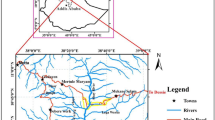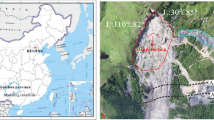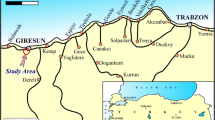Abstract
Landslides and slope failures are recurrent phenomena in the Indian Himalayas. The study area comprises the hill slopes along a road stretch of 1.5 km at a distance of 9 km from Pipalkoti on Chamoli–Badrinath highway (NH-58) in the Garhwal Himalayas, India. Based on the field survey, contour map, and the hillshade, the study area has been divided into different zones. Three different zones/slopes in this study area including one potential debris slide, one stable debris slope, and one potential rock slide have been undertaken for investigation and modeling. Field mapping, data collection related to slope features and soil/rock sample collection, and discontinuity mapping for all the slopes have been carried out in field. Soil samples have been tested in the laboratory to determine the physico-mechanical properties. These properties along with some material properties from the literature have been used as input parameters for the numerical simulation. To investigate the failure process in the debris/rock slides as well as stable debris slope, the slopes were modeled as a continuum using 2D finite element plain strain approach. Shear strength reduction analysis was performed to determine the critical strength reduction factor. The computed deformations and the stress distributions, along the failure surface, have been compared with the field observations and found to be in good agreement. The analysis results indicated rock/debris slide slopes to be highly unstable. The debris slide modeling depicted failures both above and below road levels as observed in field. The rock slide modeling could depict the exact pattern of failure involving 3 sets of discontinuities simultaneously as observed in real-field scenario which is a major limitation in case of limit equilibrium analysis. The field-observed stable slope comes to be stable through FE analysis also. Based on these analyses, landslide hazard assessment of the study area could be done.
















Similar content being viewed by others
References
Abramson LW, Lee TS, Sharma S, Boyce GM (2001) Slope stability and stabilization methods, 2nd edn. Wiley, Hoboken
Aleotti P, Chowdhury R (1999) Landslide hazard assessment: summary. Rev New Perspect Bull Eng Geol Environ 58:21–44
Cai M, Kaiser PK, Uno H, Tasaka Y, Minami M (2004) Estimation of rock mass deformation modulus and strength of jointed hard rock masses using the GSI system. Int J Rock Mech Min Sci 41:3–19
Carrara A, Guzzetti F (eds) (1995) Geographical information systems in assessing natural hazards. Kluwer Academic Publisher, Dordrecht
Deere DU, Miller RP (1966) Engineering classification and index properties of rock, Technical report No.AFNLTR-65-116. Air Force Weapons Laboratory, Albuquerque, NM
Gercek H (2007) Poisson’s ratio values for rocks. Int J Rock Mech Min Sci 44:1–13
Goodman RE, Taylor RL, Brekke TL (1968) A model for the mechanics of jointed rock. J Soil Mech Div ASCE 94(SM3):637–659
Griffiths DV, Lane PA (1999) Slope stability analysis by finite element. Geotechnique 49(3):387–403
Gurocak Z, Alemdag S, Zaman MM (2008) Rock slope stability and excavatability assessment of rocks at the Kapikaya dam site, Turkey. Int J Eng Geol 96:17–27
Guzzetti F, Carrara A, Cardinali M, Reichenbach P (1999) Landslide hazard evaluation: a review of current techniques and their application in a multi-scale study, Central Italy. Geomorphology 31:181–216
Hammah RE, Curran JH, Yacoub TE, Corkum BC (2004) Stability analysis of rock slope using the finite element method. In: Proceedings of the ISRM regional symposium EUROCK 2004 & 53rd geomechanics colloquium. Salzburg, Austria
Hammah RE, Yacoub TE, Corkum BC, Curran JH (2005) The shear strength reduction method for the generalized Hoek-Brown criterion. In: Proceedings of the 40th U.S. symposium on rock mechanics (USRMS): rock mechanics for energy, minerals and infrastructure development in the northern regions. Anchorage, Alaska. ARMA/USRMS 05-810
Hansen A (1984) Landslide hazard analysis. In: Brundsen D, Prior DB (eds) Slope instability. Wiley, New York, pp 523–602
Hoek E, Diederichs MS (2006) Empirical estimation of rock mass modulus. Int J Rock Mech Min Sci 43:203–215
Hoek E, Carranza-Torres C, Corkum B (2002) Hoek-Brown criterion—2002 edition. In: Proceedings of the NARMS-TAC conference, vol 1. Toronto, pp 267–273
Hutchinson JN (1996) Keynote paper: landslide hazard assessment. In: Bell DH (ed) Landslides, vol 3. Balkema, Rotterdam, pp 1805–1841
Kanungo DP, Arora MK, Sarkar S, Gupta RP (2010) Landslide susceptibility zonation (LSZ) mapping—a review. J South Asia Disaster Stud 2(1):81–105
Latha GM, Garaga A (2010) Seismic stability analysis of a himalayan rock slope. Rock Mech Rock Eng 43:831–843
Mantovani F, Soeters R, Van Westen CJ (1996) Remote sensing techniques for landslide studies and hazard zonation in Europe. Geomorphology 15:213–225
Marinos P, Hoek E (2000) GSI: a geologically friendly tool for rock mass strength estimation. In: Proceeding of the GeoEng2000 at the international conference on geotechnical and geological engineering. Technomic publishers, Lancaster, Melbourne, pp 1422–1446
Matsui T, Sam KC (1992) Finite element slope stability analysis by shear strength reduction technique. Soils Found 32(1):59–70
Pal S, Kaynia AM, Bhasin RK, Paul DK (2012) Earthquake stability analysis of rock slopes: a case study. Rock Mech Rock Eng 45:205–215
Patton FD (1966) Multiple modes of shear failure in rock. In: Proceedings of the 1st congr international society of rock mechanics. Lisbon, pp 509–513
Roclab (2007) Rocscience geomechanics software and research. Toronto, Canada (online) http://download.rocscience.com/ordering/FreeDownloadsForm.asp
Rocscience (2012) A 2D finite element program for calculating stresses and estimating support around the underground excavations. Geomechanics software and Research, Rocscience INC, Toronto, Canada
Saha AK, Gupta RP, Sarkar I, Arora MK, Csaplovics E (2005) An approach for GIS-based statistical landslide susceptibility zonation—with a case study in the Himalayas. Landslides 2:61–69
Savage WZ, Baum RL, Morrissey MM, Arndt BP (2000) Finite-element analysis of the woodway landslide, Washington. US. Geol Surv Bull 2180:1–9
Slide v6.0 (2012) Program for limit-equilibrium slope stability analysis. Rocscience Inc
Smith IM, Hobbs R (1974) Finite element analysis of centrifuged and built-up slopes. Geotechnique 24(4):531–559
van Westen CJ (1994) GIS in landslide hazard zonation: a review, with examples from the Andes of Colombia. In: Price M, Heywood I (eds) Mountain environments and geographic information system. Taylor & Francis, Basingstoke, UK, pp 135–165
Varnes DJ (1984) Landslide hazard zonation: a review of principles and practice. UNESCO, Paris, pp 1–63
Zheng H, Liu DF, Li CG (2008) Technical note on the assessment of failure in slope stability analysis by the finite element method. Rock Mech Rock Eng 41:629–639
Zienkiewicz OC, Taylor RL (1989) The finite element method, vol 1, 4th edn. McGraw Hill, London, NY
Acknowledgments
The authors are grateful to Prof. S.K. Bhattacharyya, Director, CSIR-CBRI for his kind permission to publish this work.
Author information
Authors and Affiliations
Corresponding author
Rights and permissions
About this article
Cite this article
Kanungo, D.P., Pain, A. & Sharma, S. Finite element modeling approach to assess the stability of debris and rock slopes: a case study from the Indian Himalayas. Nat Hazards 69, 1–24 (2013). https://doi.org/10.1007/s11069-013-0680-4
Received:
Accepted:
Published:
Issue Date:
DOI: https://doi.org/10.1007/s11069-013-0680-4




